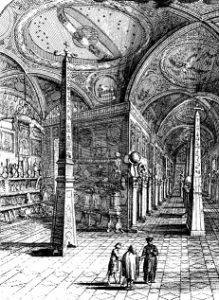 Article (book chapter)
Article (book chapter)- 60 pages
- Level: university
This article by Paula Findlen is a chapter in the 2003 book Jesuit Science and the Republic of Letters, edited by Mordechai Feingold and published by The MIT Press. Findlen discusses the museum constructed by Fr. Athanasius Kircher, S. J., in the seventeenth century—a museum filled with everything from demonstrations of optical illusions and magnetic clocks, to lodestones and asbestos, to artifacts from the cultures of Egypt and China. Findlen writes:
Kircher’s story not only sheds light on his own circumstances and on the formation of a remarkable museum; it also illuminates the importance of his religious order to early modern scientific culture. The Jesuits are one of the most important and understudied groups of scholars active during the scientific revolution. Through their vast networks and proliferation of education institutions, the Jesuits rightfully may claim to have developed one of the largest and most influential scientific communities in early modern Europe. Kircher certainly was not a typical Jesuit nor even a typical Catholic. He enjoyed privileges unavailable to ordinary members of his order, most important a great deal of latitude in his pursuit of highly unorthodox intellectual interests. Yet his prominence within the Jesuit educational system and the visibility of his museum provide us with a particularly interesting case study in the relations between Catholicism and early modern science. If Kircher was not typical, he certainly was exemplary of the tendency among Jesuit scholars to accommodate new ways of thinking alongside the old in the hope of reconciliation. In this respect, his museum served another important function: it was a meeting ground for different visions of the world, as much as it also expressed Kircher’s unique outlook on the state of knowledge…. The growing popularity of the museum and his tireless efforts to promote his work through a steady stream of publications contributed to his reputation as a man who seemed to know absolutely everything…. Kircher created scien- tific spectacles designed to please everyone. For scholars, he offered the pursuit of knowledge; for princes, an approved pastime to fill their leisure. For the curious patricians who secured the appropriate letters of introduction, Kircher promised a display that would satisfy the most theatrical sensibilities. The ability to anticipate the demands of his audience and the generosity with which he cited the work of his contemporaries made him one of the most successful natural philosophers of the seventeenth century…. Writing letters and receiving visitors, Kircher fulfilled the ideal of service that the Society of Jesus demanded, securing the position of the Roman College as a center for scientific communication and scholarly exchange.
Click here for an excerpt, courtesy of Google Books.
From the publisher, MIT Press:
Founded in 1540, the Society of Jesus was viewed for centuries as an impediment to the development of modern science. The Jesuit educational system was deemed conservative and antithetical to creative thought, while the Order and its members were blamed by Galileo, Descartes, and their disciples for virtually every proceeding against the new science. No wonder a consensus emerged that little reason existed for historians to take Jesuit science seriously. Only during the past two decades have scholars begun to question this received view of the Jesuit role in the Scientific Revolution, and this book contributes significantly to that reassessment. Focusing on the institutional setting of Jesuit science, the contributors take a new and broader look at the overall intellectual environment of the Collegio Romano and other Jesuit colleges to see how Jesuit scholars taught and worked, to examine the context of the Jesuit response to the new philosophies, and to chart the Jesuits’ scientific contributions. Their conclusions indicate that Jesuit practitioners were indeed instrumental in elevating the status of mathematics and in stressing the importance of experimental science; yet, at the same time, the Jesuits were members of a religious order with a clearly defined apostolic mission. Understanding both the contributions of Jesuit practitioners and the constraints under which they worked helps us to gain a clearer and more complete perspective on the emergence of the scientific worldview.
